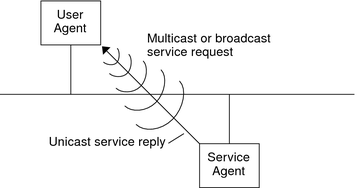| Skip Navigation Links | |
| Exit Print View | |

|
Managing Service Location Protocol Services in Oracle Solaris 11.1 Oracle Solaris 11.1 Information Library |
| Skip Navigation Links | |
| Exit Print View | |

|
Managing Service Location Protocol Services in Oracle Solaris 11.1 Oracle Solaris 11.1 Information Library |
This section outlines the fundamental operation of SLP and describes agents and processes that are used in SLP administration.
SLP provides all of the following services automatically, with little or no configuration.
Client application requests for information that is required to access a service
Advertisement of services on network hardware devices or software servers; for example, printers, file servers, video cameras, and HTTP servers
Managed recovery from primary server failures
In addition, you can do the following to administer and tune SLP operation if necessary.
Organize services and users into scopes that are composed of logical or functional groups
Enable SLP logging to monitor and troubleshoot the SLP operation on your network
Adjust SLP timing parameters to enhance performance and scalability
Configure SLP not to send and not to process multicast messages when SLP is deployed on networks that lack support for multicast routing
Deploy SLP Directory Agents to improve scalability and performance
SLP libraries inform network-aware agents that advertise services in order for those services to be discovered over a network. SLP agents maintain up-to-date information on the type and location of services. These agents can also use proxy registrations to advertise services that are not directly SLP enabled. For more information, see Chapter 4, Incorporating Legacy Services.
Client applications rely on SLP libraries that make requests directly to the agents that advertise services.
The following table describes the SLP agents.
Table 1-1 SLP Agents
|
The following figure shows the basic agents and processes that implement the SLP architecture. The figure represents a default deployment of SLP. No special configuration has been done. Only two agents are required: the UA and SA. The SLP framework allows the UA to multicast requests for services to the SA. The SA unicasts a reply to the UA. For example, when the UA sends a service request message, the SA responds with a service reply message. The service reply contains the location of services that match the client's requirements. Other requests and replies are possible for attributes and service types. For more information, see Chapter 5, SLP (Reference).
Figure 1-1 SLP Basic Agents and Processes

The following figure shows the basic agents and processes that implement the SLP architecture when a DA is deployed in the framework.
Figure 1-2 SLP Architectural Agents and Processes Implemented With a DA

When you deploy DAs, fewer messages are sent in the network and UAs can retrieve information much faster. DAs are essential when the size of a network increases or for situations in which there is no support for multicast routing. The DA serves as a cache for registered service advertisements. SAs send register messages (SrvReg) that list all the services they advertise to DAs. SAs then receive acknowledgments (SrvAck) in reply. The service advertisements are refreshed with the DA, or they expire according to the lifetime that is set for the advertisement. After a UA discovers a DA, the UA unicasts a request to the DA rather than multicasting requests to SAs.
For more information about Oracle Solaris SLP messages, refer to Chapter 5, SLP (Reference).